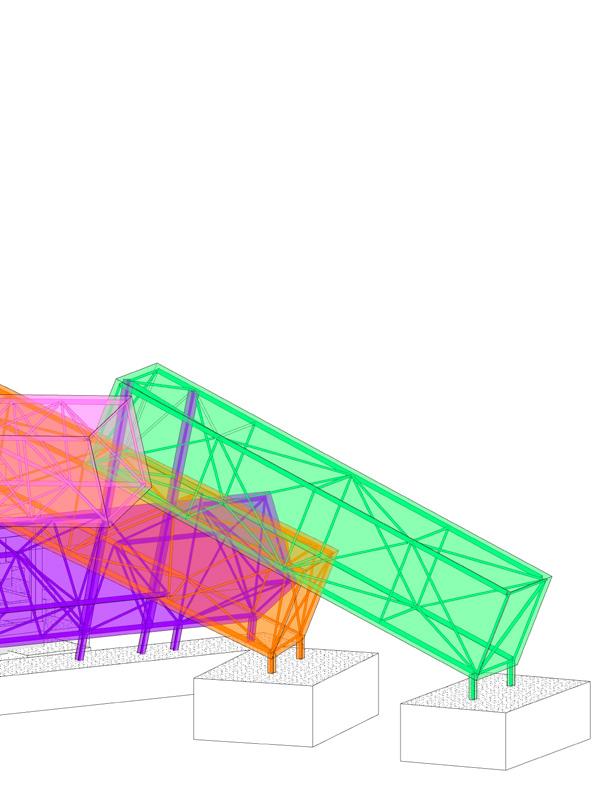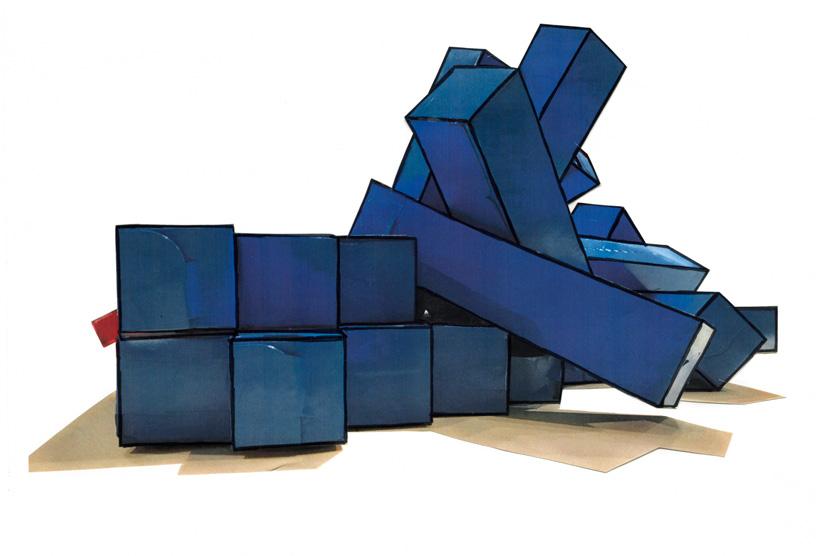
28 minute read
Making Mach1
A CONVERSATION BETWEEN ARTIST DAVID MACH AND POET RACHEL PLUMMER
R: I do creative writing workshops with the Scottish Poetry Library for young writers, I spent some time introducing them to some of your work, showing them what you do, showing them some of your previous work and the plans for the ‘Mach1’ building too, and asked them to send me some questions to ask you. They have some questions and I have some as well! I thought we’d start off with getting you to tell us a bit about yourself and what you do.
Advertisement
D: I’m a sculptor. I’ve been making sculpture for forty or fifty years – I think I was actually a sculptor very early on; when I think about things I did as a kid, I was moving huge rocks around the beach, damming streams, all that kind of stuff was all very physical, three dimensional stuff, I didn’t know that was sculpture at the time, I didn’t think about being an artist or anything, it was just things you do as a kid, I liked playing with stuff. Where I was brought up there was plenty of stuff, I was brought up in a very industrial neighbourhood as well as on beautiful beaches and gorgeous countryside, there was everything, I had the best playground in the world. I try to make my way to that playground every time I make something, whatever it is, wherever I am. I make huge installations, I make tiny little pieces, I make hundreds of collages… It’s like guerrilla warfare for me, making art –you get to comment on the world, you get to say what you like, you get to say it how you like. People make of that what they will, with a bit of luck, they like what you do, but if they don’t, you’re not going to be crying yourself to sleep at night either, it’s a thing you just do.
It’s a bit like poetry. Poetry’s a new thing for me. I’m not a poet but I’m putting some words together and I’m surprised by how something will come at you, but I shouldn’t be! It’s the same as art, art comes at you, you think about things, you have a feeling about something, you pick up a material, you get excited by it, you see, hear, feel, smell something and it affects you. Putting that into words is a new thing for me, making things is my usual pastime so I’m pathetically thrilled by words.
R: I can really imagine you being interested in some of the concrete poetry or landscape and installation poetry, poets like Thomas A. Clark who invites you to physically walk down a trail to enjoy a poem or enter a room and have the poems on the walls or on objects.
D: It’s funny, I was never interested in this kind of stuff and have only recently found an interest because I’ve been writing myself, but I’m very interested in the Humanist side of things, the sardonic or critical side of things, what you can say and how important it is to say things and just be yourself, the self that exists on this bloody planet. For instance, I like stand up comedy, it’s a fantastic thing, we’re a country that is rich in that material. It’s as if I’ve been training for decades to get to a point where I can write a poem that’s only ten sentences long. It’s taken me that long to get to this point and I think “What a twit! I could’ve been doing this a long time ago!” But maybe I couldn’t, maybe I’ve had to go through loads of bushes and crossroads, etcetera, to get to this point. Maybe there are timings for you to do things.
R: Do you have plans to develop your poetry?
D: I do. Unfortunately, I’m completely snowed under with loads of different pieces of work. In my ideal world, I’d be working on architecture, sculpture, collages, poetry, music, and I’ve got about two or three books on the go as well. For a while I was managing to make all of that roll over and keep progressing, but then, recently, not so much because of COVID, but the things around it have slowed things down. There was a point I was getting up at three o’clock in the morning and working until eleven o’clock at night in order to achieve all of those things but I think you just get tired. Now I’m getting up at eight in the morning… I used to be writing things in the middle of the night because they were coming at me in the middle of the night, but I’d also be going to things, there would be parties, there would be celebrations where people would ask me to say things. I thought it was weird that I actually wanted to read what I was writing to people. To me, it’s really important how you read things in different scenarios. I also like the collaboration in poetry, as well as the emotion. I’m a good crier. I cry every night watching the TV, I cry watching adverts for digestive biscuits. You could employ me as a mourner at a funeral and get good value for your money. I like things to be emotional, so you know you’re involved and not in a light way, I think it’s good for you. I like when you read something and it catches in your throat, because you really get it.
R: It’s that same feeling of awe that you can get from a lot of different kinds of arts and it makes you think “I want to give someone that feeling.”
D: The funny thing is, is that I rarely get that feeling. I get it from my own art but hardly ever from other pieces! I do from time to time, but I think maybe I’m around so many different things that I maybe take it for granted. If I’m watching a film or listening to music especially, I like the honesty involved – art I’m suspicious of, I’ve always been very suspicious about it, even though I’m heavily involved, especially contemporary art, very suspicious of that. Whereas I’m less suspicious of music, in fact I’m not really suspicious of music at all, I’ll know instantly if it’s shite or if I’ll love it. I think I look at art that way as well but we’re always encouraged to “wonder what the artist meant” and all that bollocks, I can’t deal with that! Music and writing give you the honest meaning immediately and you can tell if it’s bullshit or whether the words are important to you. This honest meaning seems to be more important than ever at the moment. In the world that we live in, everyone’s lying about every damn thing under the sun and getting away with it. It’s a strange thing that the artists are the ones telling the truth, or maybe it’s not! Maybe it’s always been like that and I’m just being naïve, I don’t know.
R: Madeleine, who is nine years old, says “I really like your sculptures, and the ‘Mach1’ building, because they’re so unexpected, my question is: have you always looked at the world like this, and what sort of things did you make when you were nine years old?”
D: I think I probably have always looked at the world like this. The great thing about being a kid is how you can look at the world. I would lie in bed and redesign my whole bedroom into the headquarters of Joe 90 with things I was going to make out of Kellogg’s Corn Flakes packets. I’m still using Kellogg’s Corn Flakes packets, I actually cut the card out and make collages on the back of them, I love using that stuff. As a kid, I used to love staring at the back of the packet, it didn’t say very much and it was the same thing every day, but somehow you could still read it and have this other world open up to you that’s bigger or more exciting than it seems to someone who looks at you reading the back of the packet.
We were super active as children, I think my first assistants were six years old, I’d get them to help me dam the streams and the little burns that ran through the golf course, we used to try and flood the golf course, you couldn’t do it by yourself, you needed half a dozen other kids to help you. People would stop playing and say “you’re just making us work!” My environment was incredibly physical with the actual industries that were going on, I lived right by a brickworks and you sort of partook in it, it was as if someone had injected me with the attitude of “you need to use that stuff for something!” That attitude was in the water that you drank or it came up through the soles of your feet, or in the air that you breathed and I still feel it. I guess I haven’t grown up in that sense, and I think probably partly because growing up is well overrated.
R: It’s interesting what you’re saying about the everyday objects like the cereal packets and the brickworks. I really think that that’s what a lot of poetry is trying to achieve: to look at everyday objects in a new way and seeing the possibilities in them, or being able to bring the reader’s attention closely down to them. It’s interesting what you say about children naturally looking at the world in this way, maybe, as adults, we’re trying to recapture that.
D: It’s the nuts and bolts of your life, but if all you have is just the basic nuts and bolts, you’re going to be bored shitless. If you’re in the world of your imagination and you find yourself in the situation that that’s what your job is, then for me that’s a great place to be. Kids are great, aren’t they? They have imagination in spades. An adult could be struggling to pick up on something but a kid will get it straight away. Imagination is surviving when you’re a kid; it’s surviving your parents being happy, your parents being sad, your parents being poor, whatever it is, they can come out of it grinning.
I used to lecture my daughter in the car. She was five and I’d be like: “Right, you’re the kid, you get all the fun. I’m the dad, I do all the worrying. You’re the kid, etcetera!” And we’d go on like that for a while. I want that freedom for everybody. It’s a bizarre thing, you can read a poem to somebody and they can go “Jesus…” or you can show somebody your work of art and they can just be embarrassed, or horrified, or hate you! But I’m like come on, bring it on, which probably isn’t an easy thing for adults.
R: Kids are unselfconscious, they aren’t worried about what people will think, they just want to do things so they do.
D: We train kids to be self-conscious. How we live, how we educate, how we pressure, how we judge… We make them self-conscious.
R: That’s a big part of why I homeeducate my daughter. I want her to have so much of that in her life.
What comes first for you when you’re making something? Do you start with these materials and play with them, and end up with something, or do you have an idea in your head? When you’re lying in bed are you thinking about your cereal boxes or do you get an idea and then try to make it?
D: It’s a total mix. I’ve made hundreds of installations when I’ve been trying to figure out how to work with something. Someone had given me 25 thousand biscuit fired plates when I used to work in a gallery in Stoke, and I thought they were horrible things, I didn’t know what I was going to do with them. But it was persevering and finding out by mistake what worked, they used to fall apart because they were only biscuit fired, they weren’t strong enough to support themselves. I build a column and it just snapped, a but of a plate when firing across the room and I went “I like that.” So, I just kept doing it until the whole room was just filled with broken bits of plates flying about the place, then the whole thing lifted itself up and threw itself into the air, it was bizarre! And then

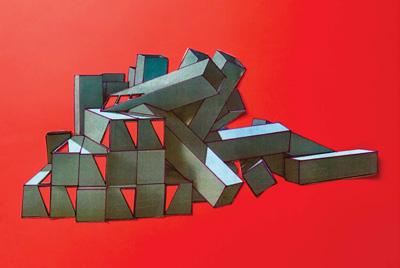
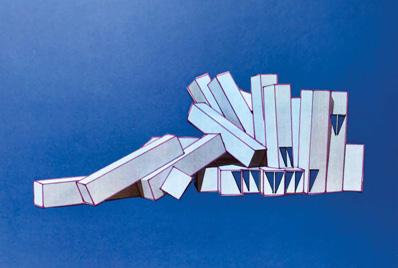
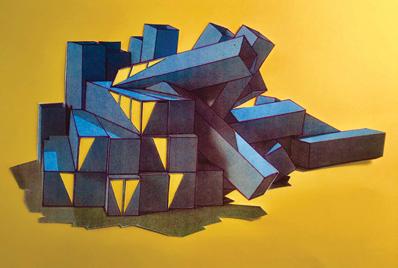

I got stopped because it was dangerous, but I did find a way of working with it. Other times it’s easier than that, sometimes I have a feeling about something, other times I have to hone it a bit. Then other times, I have complete ideas. I remember reading about Elvis Costello before mobile phones, he would phone his own answering machine and hum the melody that was in his head so he didn’t forget them when he was out and about. I think that’s fantastic, I think poetry is similar; I’m listening to the news or something, two words will connect and I find myself writing those things down and wondering if it’ll fit with something else I’m working on, it’s a constant moving thing.
I like things not to cancel themselves out. You can do that really easily by forcing something. By forcing a material: “I’m going to bend you, you little bastard!” but often you don’t need to do that, you can find a way of working with materials, let them tell you how they’re best manipulated. I’ll find the energy in things, whether it’s a tune, a word or a physical thing and if you’re open enough to follow it, it works. It’s letting the tail wag the dog. It’s an odd, odd thing. Making a collage is like sitting on a horse the wrong way, steering it with a tail and shouting the directions to the head, it’s odd. There’s no logic that works. I find myself wrestling with tiny little bits of paper the whole day and I’m exhausted after a day’s work, even though it just looks like I’m mucking about, but I feel like I’ve gone fifteen rounds with a wrestler, it’s ridiculous. Sometimes I just couldn’t get things to do what I wanted them to do, then I’d leave them for a while and when I came back it was obvious I just needed to go with it and vibe with the thing, rather than trying to make it into the thing that’s in my head, I make it into the thing that it wants to be.
R: I think it’s really similar with that form a poem has to take. You can decide “I’m going to write a sonnet,” or “I’m going to write a villanelle,” but once you start, often it will take you in a different direction, it’ll tell you what it wants to be. It’s always better to go with it, it’ll always end up a better poem than if you try and force it into something that doesn’t quite fit it.
D: It’s difficult because you want things to bend to your will, you have a little internal battle with it. These are things you have to do a lot of to see what works, sometimes it does work and sometimes you think “oh god, that’s shit.”
R: Zach who is ten asks: Do your projects ever look different to how you imagined them and does that make you feel frustrated?
D: Oh god, he’s going to be an architect is Zach! Architects must have that problem all the time, thinking they want it to look a certain way and the client says “well, I’m sorry, it’s not going to look like that.” It’s funny, when I first introduced the idea to Peter Millican from Parabola, and he had Chris Milan, the young architect, I didn’t know if I was going to get the job or not, I speak to everybody the same, so I said “this is how it looks, now don’t f*** it up.” Because architects will do that, they want to shift the angles or the degrees, or they’ll say things can’t be done because they need to be wired up or goodness knows what else. But with this thing, the design of ‘Mach1’ is so cranky, that even if it was fiddled with a bit, it still looks good, it fits the bill in a number of ways, it can be interfered with and still look like the thing I want. Either that or I’m getting soft! But I did give very clear instructions not to f*** it up and they seem to be following that to the letter. I’ve seen the plans, the drawings and the models, and it looks pretty much the same to me! I expect tweaks, it’s a building, but it looks good.
The most fascinating thing with Zach’s question is that he’s interpreted the rest of his life, where people step in and say “No! You can’t do it like that, you’ve got to do it like this.” And he we are thinking we don’t want to do it like that, I want to do it like this but this is the real world that we live in so too bad, you know?
R: I think Zach already feels like that when he’s writing, often he has very grand ideas in his head, he’s the kind of person who plans a whole series of novels but he can’t necessarily fulfil what he wants to write and it makes him frustrated. Often he’s one of the kids who has tried the hardest but at the end of the class hasn’t got much to show for it because he feels like it isn’t working the way he had imagined.
D : For a youngster, that’s quite an interesting thing. My daughter’s just started Halifax University in Nova Scotia in Canada. When she arrived, she had to quarantine for two weeks, and it’s all got to be online learning. I got a call from her mum saying “Has she told you?” and I said “Told me what?” I’m thinking oh my god, what’s happened, I’m really worried, and it turns out she got a bad mark for her chemistry. She’s set herself up for a certain standard for herself and it just makes me laugh, like “you’re talking to the guy who was the thickest guy in the class.” They used to sit me next to this girl at school who used to weep because she wasn’t going to meet her imaginary standards, and I’d be sitting there, patting her on the back going “think about me, I’m going to be nothing,” but I couldn’t get her to relax at all. That intense feeling that people have where they feel they have to achieve something, I didn’t have that. Don’t get me wrong, I can be frustrated when things aren’t working out. I’ve also had a lot of assistants and I’ve told them, I don’t want to make something that looks kind of like the thing I want, I want to make the thing that I really want, and it’s your job to make it that way, not they way you think it should be done or anyone else and that’s a really hard thing to achieve. It’s a different thing to naked ambitions of wanting to be a “thing”, I don’t know if I ever had that. I have lots of ambitions now but I never used to.
Funnily enough, in relation to ‘Mach1’, I saw an E Type Jaguar at five years old and thought “I want one of them, I’m going to be an architect because they make loads of money,” but a week later I was back to having no ambition, which there’s nothing wrong with. I think at an early age, I figured I have to be able to deal with this. I’ve never liked to worry, I think worrying is well overrated. I don’t feel guilty about very much either. I think when you’re a kid, not worrying is a fantastic thing. Worrying about what you’re going to be doing when you’re twenty-five when you’re only ten is something odd.
R: I think there’s a lot of that. There’s so much pressure on young people from such an early age and there doesn’t seem to be much point to getting high scores, etc.
Audrey, who is nine, asks: The sculptures you make are things that can’t be used, does it feel different now to design ‘Mach1’, something that is going to be used?
D: Wow, she’s in the same book as Zach! Are you training a class of young fascists or something?
R: I’m really trying not to! It’s really interesting because I spend a lot of time with them talking about what poetry is and we have these big, long discussions about it and in the end, we decide that maybe anything could be a poem. So, I ask is a chair a poem and they all say “No!” so I ask well, could it be? How could we make the chair into a poem? And we think about things really deeply, so it’s really interesting to have them come back with these ideas that are still quite rigid.
D: It’s really rigid! You have to persevere in there. I actually find it quite funny. Obviously, we know that there is use for art and it doesn’t necessarily have to qualify in a certain way. I remember the ruination of art colleges, when they decided not to give people diplomas but give them degrees, if you want to get a degree, you have to write an essay about it and once you write an essay about the thing, it becomes something else. All of that started way back in the 70s, to make art more “useful”, to qualify it. To qualify is something that we all do all of the damn time, we can’t help ourselves. “I don’t like the way your arse looks in those jeans, I don’t like those shoes being too pointy, I like square toes, your jacket reminds me of Harrods, it’s a posh green…” We make judgements about every bloody thing under the sun, thousands of times a day, and most people are so unforgiving. When you go to art college, it’s almost as if you’re trained to be hypersensitive. As a sculptor, I’m so sensitive about where things are, and their positioning, whether they’re millimetres one way or the other, and you get home and you need to relax, you put your keys on the table, then you go back and move them just a couple of inches because it wasn’t quite right before, it wasnae the spot they should be left in… So, to have the qualification of “useful”, it’s quite odd, I’d quite like to be described as useless actually. I think I probably have been called useless before! There’s something kind of “f*** yeah!” about it, or anti-establishment.
R: I think that’s it and that’s at the centre of all art, you’re making something that’s not necessarily necessary for survival, it’s just something we’re compelled to make – maybe that is its necessity though!
D: Yeah, I think it is necessary for survival. I think if you take it away, terrible things will happen. Art comes in very, very, very many forms. You may or may not know that, you may only discover it when you’re 85 and lying on your death bed and it’s something that someone has to point out to you, or you just don’t get it at all. But we weren’t put on this earth just to make things useful, that’s for sure.
R: I agree with that, very much. One of the main problems I have with the education system; we don’t learn so we can get a job and work 9-5 in an office, we learn because we’re a curious species and it’s part of what makes us human.
D: Wouldn’t it be great if they actually said we’re going to change the entire education system, we’re going to stop f***ing about and everybody’s going to be creative. We can learn things that are handy to know, but we’re going to build a nation of thinking, doing daft folk that invent amazing things on the back of it. While they’re doing that, also having a brilliant time, thank you very much! We’re not all capable of working how things currently work and I fear for how that all ends up, with everyone getting home on a Monday and dreading the next four days before the weekend. Life shouldn’t all be about achieving and ambition and all of that, you can make plenty money doing plenty of things, but you can have a bit of fun while you’re doing it and not be such a dick – that’s a message to the education sector!
R: That leads us nicely into my next question which is: what advice would you give to young people who are interested in art?
D: Whoa there. It’s funny actually, I was just telling someone to paint flowers. I was laughing because, in contemporary art, we all get very serious and up our own backsides about the whole thing but I do think that things in the art world have opened up again. It’s now possible to pop up out of the woodwork with something and have someone go “wow!” and we can do something with that kind of attitude. I would say that if you had any sense as a teacher, you would say “Look, stop pissing about and just paint flowers!” The richest artist in Scotland is probably Elizabeth Blackadder, and everyone goes “Ah, she just paints flowers.” Yeah, get on with it. So, I was recently saying that to someone and I thought I would actually take my own advice, I’m going to try it and see if I come out with the same sort of thing. The art world does this thing where it teaches you to be a terrible snob about every damn thing under the sun, it’s fascinating as all hell. The question “Who the f*** do you think you are? ” crops up all the time and I’ve always found that quite difficult to deal with, whilst also being right in the middle of it, it’s what I do. So, I’m really suspicious and I think it’s important to be suspicious. Crack on with it, but be suspicious of other people’s motives, but also your own; what is it that you think that you’re doing? Don’t think “Why does the world need this?” I’m perfectly aware that the world doesn’t need another David Mach making anything, but I’m quite happy to still be doing it. It obviously irritates quite a lot of folk, but I’ve decided that one of my best qualities is being irritating, it’s not that bad a quality.
R: It’s a good quality!
D: Say no a lot. Do your own thing. Find stuff that you like, that’s the way forward, it’s the stuff that you like that will make you creative. If you actually like adding up figures you’re going to have a very happy career as an accountant, you have to find the thing that makes you happy.
R: That’s really good advice, for everybody. Within the art world, that can by cynical and snobby, is there anything that’s exciting you at the moment, that you’re finding really interesting?
D: I’m always interested in music. I’m a drummer, it took me about 40 years to realise that rhythm and the repeating of something, whether it’s hitting a drum or using the same materials in art again and again, which I do a lot, it’s that that is very important to me. I can be a very, very slow learner, it took me ages to realise that I just keep doing things. With drumming, I’ve bloody been doing that since I was about 12 or something, and I get over excited by good music. I love stories, I don’t see a lot of actual artworks, I’m very excited by my own, I have to say, if I’m really honest. I’m chock-a-block with ideas at the minute, and I really need to get my arse in gear and get working, I’ve been thwarted a little bit over the last three or four months and I need to get cracking and make these things. I don’t want to leave anything behind, I want to take every idea with me, every man with me. I don’t want to leave them floundering like a wet fish, you take it all and that’s how you find out what you’re doing. You need to work hard. That’s advice I’d give: put the effort in, don’t pretend you’re putting the effort in, don’t do anything half-heartedly, do it all full on, if you can.
I’m still enthused. The architecture thing, when we were working on the new project, I was really interested in that, I shouldn’t really have done that because we wernae going to make any money out of it, but I spent months working on this particular thing, knowing I wasn’t really going to get the job. My girlfriend and the people in the studio were saying I should have been working on other things and I was saying “I don’t want to, I want to do this!” I get pathetically excited by that sort of stuff. The same with bits and pieces of words. I finished my book off, but now I have to edit the damn thing and I’m finding that quite hard. Before, I was working with a mate, he was helping me with it and we’d have a great laugh, he’d come in a few days a week and we’d be busy working on it. We’d be batting ideas backwards and forwards, we’d be giggling at the lunacy of it all, and you kind of need that.
To be honest, I’ve been unequivocally, ridiculously spoiled rotten my whole life by all of this, I can’t complain about that at all.
R. I thought it was interesting what you said about the music, because when I first saw the ‘Mach1’ drawings I thought it would be a really interesting place to perform music with the kinds of resonances inside and the shape of it and the materials and while things have been stymied by the pandemic but there is a cellist who I’ve been wanting to work with who works with poets and I was really keen to do a performance of poetry with his improvised cello and his electronic devises.
D. Thanks interesting, I think about it as a place for that kind of thing.
R. And even the name itself ‘Mach1’ makes you think of sound.
D. Thanks funny because I work with a guitarist whose fantastic, an Australian guy who plays like an angel and I thought I’d like to read some poetry and have him play alongside and improvise but we could never get it right, then I thought I could drum alongside somebody that was speaking. That would be an odd thing, you know? But I don’t think I’m that good a drummer to actually do that and I’d be worried about performing, but you know what’s interesting is the collaboration and as an artist, collaboration is not something I’ve been guilty of – hardly ever! It’s not an ego thing or “This is mine!” but I am more interested in collaborating with a musician or a writer and that kind of opens you up a little bit an I think that’s very important and finding something new like that doesn’t happen a lot.
R. I agree. I often find that I get most of my inspiration from other mediums and from other media from what I work in, I’ve worked with cellists in the past, I found that really interesting, or in this project, writing about this artwork and building. I like to write about buildings, I think that’s really interesting.
D. That’s a really fascinating thing to do. I did a portrait of two companies once and I thought “how do you do a portrait of a company?” and I actually got two works of art out of that that I really like a lot and I was surprised. I think that’s valuable stuff when you surprise yourself and I also like to be pressured, I like to do things where there’s somebody watching you, I like the performance. I think being a witness for something is very important and you can be a witness by hearing, by looking, by tasting, by touching but the thing about this Zoom thing is that it removes you from that closeness, it’s not good, I think you need to be there. It’s interesting with music because you can hear music in your head and you carry it with you and for an artist that’s interesting and I’m forever meeting people who want to leave a legacy and I’m just thinking “you’re just leaving a pile of crap!” but the biggest things in your life, the best meal you ever had or the things you remember, stay with you. You can’t hear the Rolling Stones now but if you had ever been to one of their concerts and you were up there in your chair balling and shouting and behaving like an idiot, then you remember stuff like that and it’s the stuff you haul along and that’s valuable rather than the stuff that slows you down – this is the stuff that makes you light and airy and you kind of need that you know ‘cause the world’s a silly bugger place! And how you get through it, fairly well intact is important.
R. Yeah, I think that’s a really powerful way to think of it, as the things that lift you up and make you lighter or the things that weigh you down and drag you back. That’s a really good way of describing it.
I’ve got a couple of similar questions from Rory who’s nine and Erol, who’s eight. Rory asks: “Why shipping containers?” and Erol asks “How did you get the idea for the way the building looks and what inspired your initial drawing?” and Erol also says that if he had one of your match head sculptures he would keep it for a long time and then accidentally/deliberately set it on fire – he wanted you to know that!
D. Ha! That’s actually happened quite a few times!
The shipping containers are something I’ve been interested in for decades. I used them once to make a couple of Greek temples and I wrapped tyres around them and made columns around them. They were perfect; four forty-foot shipping containers in a block made the perfect shape for the columns around the block, and then I thought, hang on a minute, this is really weird, these shipping containers actually look like Greek temples they have, that’s same the squat gable end and they’ve even got columns running down the side and I began to think of them like that. Then I started to use them as plinths and sat heads on top of them, and I started getting interested in what I could do with them and I had a couple of huge Sumo wrestlers holding them up. I could write essays about them because suddenly you realise that every single thing you buy in the world has been transported in these things, so every PCU, your jeans, your washing machine, that’s all been transported and its all been made to fit and they shape the world – physically they shape the world. They have been dropped from the sky accidentally in Amazonian forests and worshipped by tribes a bit like the big block in 2001: A Space Odyssey – there are loads and loads of aspects to them that are really interesting. My wife used to say “You have a really unhealthy interest in that big metal box.”
When they were looking for an idea for Edinburgh Park, I heard through the gallery that Parabola wanted to use shipping containers. There are lots of container buildings but they are all the same, they are stacked up and great looking things but I said “I’ve got an idea in my head!” and I went and bought lots of Bacofoil packets – we had enough Bacofoil to keep us going for five years! And they were roughly the right dimensions, I’d chop each box into three bits and I just started putting them together and cutting into them because the way to make the architecture is not just to imagine it or do a drawing, it’s to work it out physically and that paid dividends once we started talking to the engineers because the way we put it together actually counterbalances the weight. And that’s how you actually put it together, its not fake, as a sculptor that’s what you would do to make it become a real thing that can actually stand up by itself so you find yourself having engineering skills just because you’ve been manipulating “stuff” for forty years.
I was laughing with my daughter that just before she was upset for getting a poor mark for her chemistry, she got a great mark for her engineering drawings, which were done on CAD, and I was laughing because I failed my
Engineering drawing twice and they gave me a complimentary O-Level because my drawings were really good but my calculations were shit! I did Applied Mechanics at schools as well and I was crap at Applied Mechanics, but I apply Applied Mechanics physically all the time when I make sculpture to the point where I could build you a bridge without working out the stresses and strains and that’s just experience of working stuff out!
We were stuck in Kiev once making an exhibition and we were putting the first Sumo Wrestler sculpture together which is two Sumo wrestlers holding up this box together, like two removal men and a piano. We had to lift a two-tonne shipping container six feet into the air to sit it on this table which would go between the Sumo. We had three weeks to make it and they would never bring us the crane, “there are no cranes in Kiev?” So, I was working with my assistant, Adrian, and I said “I know how we can lift this thing by ourselves…” and we worked out between us how we could lift a 2-tonne container and there’s no way that two men should be able to do that and we worked out a way that if the crane didn’t come, we could lift it – it would take a lot of effort but we were up for it and the day we were going to start doing it the crane showed up! I always wished we had been able to make the effort to lift that thing and I’ve had to stop myself lying about it and saying that we actually did that by hand, just to tell a tall story. We should actually maybe just do it one day just for the hell of it before we get too old and decrepit.
R. My final question is what do you think people will take from the ‘Mach1’ building?

D. I think it will be quite popular, I think that people will smile, they’ll grin when they see it. I always say when I make art, “I want people to laugh and to smile and to start crying because you’re emotionally pushed over the edge, I want you to reach into your pocket and throw money at me, I want you to applaud and I want you to run away screaming!” That’s the kind of reaction I want, I don’t want you to walk by and say “What’s that? – I don’t need that.” I think people will like it and folk will hate it as well – it’s one of those things, people will say “What the hell is this? Who the hell do you think you are?” Especially in Scotland – I come from Fife, but I used to say I come from “Who the hell do you think you are?”
I tell myself that every day, I like to be infiltrating and I feel like I’ve infiltrated architecture so other architects might now say that exact thing from a different angle “Who the hell does he think he is?” – and I like that about art, that it can make you find your way until you’re sitting next to the Queen having lunch and she’s passing you the salt, and you’re waiting for someone to tap you on the shoulder and you go “OK, I’ll just get my coat.” There’s something about poetry and music and sculpture that enables that to happen and that’s a personal revelation to me that you can get involved, and if they would teach you that as a kid then, whoa!
